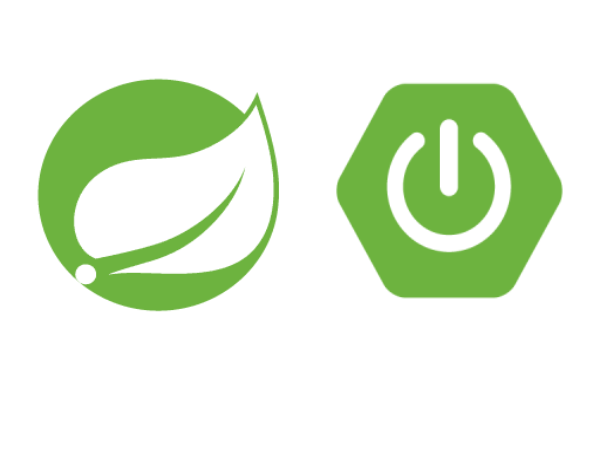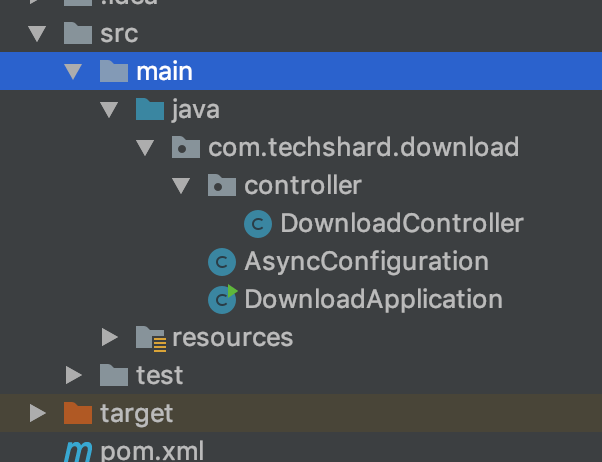
Потоковая передача данных — это принципиально новый подход к отправке данных в веб-браузеры, который обеспечивает значительно более быстрое время загрузки страницы. Довольно часто нам нужно разрешать пользователям загружать файлы в веб-приложениях. Когда данные слишком велики, становится довольно сложно обеспечить хороший пользовательский опыт.
Spring предлагает поддержку асинхронной обработки запросов через StreamingResponseBody . При таком подходе приложение может записывать данные непосредственно в ответ OutputStream без удержания потока контейнера сервлета. В Spring есть несколько других методов для обработки асинхронных запросов.
В этой статье мы рассмотрим пример загрузки файлов с использованием StreamingResponseBody . При таком подходе данные обрабатываются и записываются частями в OutputStream.
Настройка проекта Spring Boot
Создайте пример приложения Spring Boot. Вот мой пример структуры проекта. Я создал проект вручную, но вы также можете создать его с помощью Spring Intializer .

Давайте добавим несколько основных зависимостей в Maven POM.
<?xml version="1.0" encoding="UTF-8"?>
<project xmlns="http://maven.apache.org/POM/4.0.0"
xmlns:xsi="http://www.w3.org/2001/XMLSchema-instance"
xsi:schemaLocation="http://maven.apache.org/POM/4.0.0 http://maven.apache.org/xsd/maven-4.0.0.xsd">
<modelVersion>4.0.0</modelVersion>
<groupId>com.techshard.streamingresponse</groupId>
<artifactId>springboot-download</artifactId>
<version>1.0-SNAPSHOT</version>
<parent>
<groupId>org.springframework.boot</groupId>
<artifactId>spring-boot-starter-parent</artifactId>
<version>2.1.4.RELEASE</version>
<relativePath />
</parent>
<dependencies>
<dependency>
<groupId>org.springframework.boot</groupId>
<artifactId>spring-boot-starter-web</artifactId>
</dependency>
<dependency>
<groupId>org.springframework.boot</groupId>
<artifactId>spring-boot-starter-actuator</artifactId>
</dependency>
<dependency>
<groupId>org.springframework.boot</groupId>
<artifactId>spring-boot-starter-security</artifactId>
</dependency>
<dependency>
<groupId>org.slf4j</groupId>
<artifactId>slf4j-api</artifactId>
</dependency>
<dependency>
<groupId>org.apache.commons</groupId>
<artifactId>commons-io</artifactId>
<version>1.3.2</version>
</dependency>
</dependencies>
</project>We will now create a controller and add an API endpoint for download. Here is my complete controller.
package com.techshard.download.controller;
import org.slf4j.Logger;
import org.slf4j.LoggerFactory;
import org.springframework.http.HttpStatus;
import org.springframework.http.MediaType;
import org.springframework.http.ResponseEntity;
import org.springframework.web.bind.annotation.GetMapping;
import org.springframework.web.bind.annotation.RequestMapping;
import org.springframework.web.bind.annotation.RestController;
import org.springframework.web.servlet.mvc.method.annotation.StreamingResponseBody;
import javax.servlet.http.HttpServletResponse;
import java.io.*;
import java.util.zip.ZipEntry;
import java.util.zip.ZipOutputStream;
@RestController
@RequestMapping ("/api")
public class DownloadController {
private final Logger logger = LoggerFactory.getLogger(DownloadController.class);
@GetMapping (value = "/download", produces = MediaType.APPLICATION_JSON_VALUE)
public ResponseEntity<StreamingResponseBody> download(final HttpServletResponse response) {
response.setContentType("application/zip");
response.setHeader(
"Content-Disposition",
"attachment;filename=sample.zip");
StreamingResponseBody stream = out -> {
final String home = System.getProperty("user.home");
final File directory = new File(home + File.separator + "Documents" + File.separator + "sample");
final ZipOutputStream zipOut = new ZipOutputStream(response.getOutputStream());
if(directory.exists() && directory.isDirectory()) {
try {
for (final File file : directory.listFiles()) {
final InputStream inputStream=new FileInputStream(file);
final ZipEntry zipEntry=new ZipEntry(file.getName());
zipOut.putNextEntry(zipEntry);
byte[] bytes=new byte[1024];
int length;
while ((length=inputStream.read(bytes)) >= 0) {
zipOut.write(bytes, 0, length);
}
inputStream.close();
}
zipOut.close();
} catch (final IOException e) {
logger.error("Exception while reading and streaming data {} ", e);
}
}
};
logger.info("steaming response {} ", stream);
return new ResponseEntity(stream, HttpStatus.OK);
}
}In this API endpoint, we are reading multiple files from a directory and creating a zip file. We are executing this process within StreamingResponseBody. It writes data directly to an OutputStream before passing that written information back to the client using aResponseEntity. This means that the download process will start immediately on the client, while the server is processing and writing data in chunks.
Start the server and test this endpoint using http://localhost:8080/api/download.
When using StreamingResponseBody, it is highly recommended to configure TaskExecutor used in Spring MVC for executing asynchronous requests. TaskExecutor is an interface that abstracts the execution of a Runnable.
Let us configure the TaskExecutor. Here is the AsyncConfiguration class which configures timeout using WebMvcCofigurer and also registers an interceptor that is called when there’s a timeout in case you need some special handling.
package com.techshard.download;
import org.slf4j.Logger;
import org.slf4j.LoggerFactory;
import org.springframework.aop.interceptor.AsyncUncaughtExceptionHandler;
import org.springframework.aop.interceptor.SimpleAsyncUncaughtExceptionHandler;
import org.springframework.context.annotation.Bean;
import org.springframework.context.annotation.Configuration;
import org.springframework.core.task.AsyncTaskExecutor;
import org.springframework.scheduling.annotation.AsyncConfigurer;
import org.springframework.scheduling.annotation.EnableAsync;
import org.springframework.scheduling.annotation.EnableScheduling;
import org.springframework.scheduling.concurrent.ThreadPoolTaskExecutor;
import org.springframework.web.context.request.NativeWebRequest;
import org.springframework.web.context.request.async.CallableProcessingInterceptor;
import org.springframework.web.context.request.async.TimeoutCallableProcessingInterceptor;
import org.springframework.web.servlet.config.annotation.AsyncSupportConfigurer;
import org.springframework.web.servlet.config.annotation.WebMvcConfigurer;
import java.util.concurrent.Callable;
@Configuration
@EnableAsync
@EnableScheduling
public class AsyncConfiguration implements AsyncConfigurer {
private final Logger log = LoggerFactory.getLogger(AsyncConfiguration.class);
@Override
@Bean (name = "taskExecutor")
public AsyncTaskExecutor getAsyncExecutor() {
log.debug("Creating Async Task Executor");
ThreadPoolTaskExecutor executor = new ThreadPoolTaskExecutor();
executor.setCorePoolSize(5);
executor.setMaxPoolSize(10);
executor.setQueueCapacity(25);
return executor;
}
@Override
public AsyncUncaughtExceptionHandler getAsyncUncaughtExceptionHandler() {
return new SimpleAsyncUncaughtExceptionHandler();
}
/** Configure async support for Spring MVC. */
@Bean
public WebMvcConfigurer webMvcConfigurerConfigurer(AsyncTaskExecutor taskExecutor, CallableProcessingInterceptor callableProcessingInterceptor) {
return new WebMvcConfigurer() {
@Override
public void configureAsyncSupport(AsyncSupportConfigurer configurer) {
configurer.setDefaultTimeout(360000).setTaskExecutor(taskExecutor);
configurer.registerCallableInterceptors(callableProcessingInterceptor);
WebMvcConfigurer.super.configureAsyncSupport(configurer);
}
};
}
@Bean
public CallableProcessingInterceptor callableProcessingInterceptor() {
return new TimeoutCallableProcessingInterceptor() {
@Override
public <T> Object handleTimeout(NativeWebRequest request, Callable<T> task) throws Exception {
log.error("timeout!");
return super.handleTimeout(request, task);
}
};
}
}Conclusion
Using StreamingResponseBody, we can now stream data easily for highly-concurrent applications. I hope you enjoyed this article. Let me know if you have any comments or suggestion in the comments section below.
The example for this article can be found on GitHub repository.